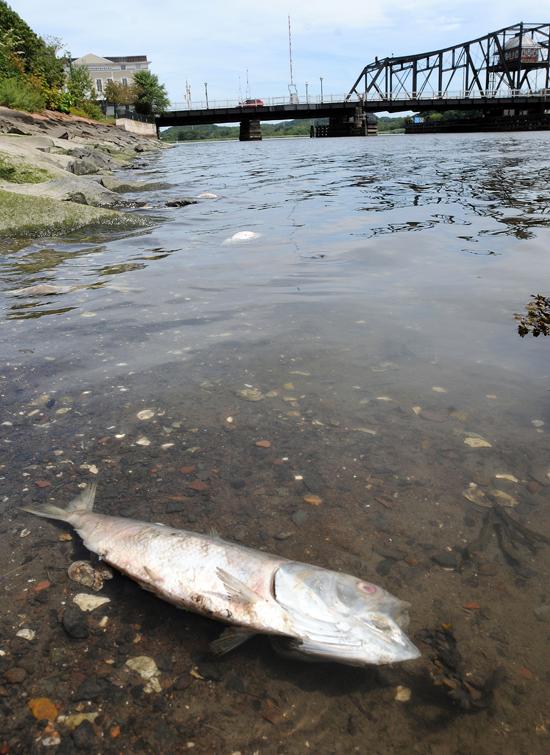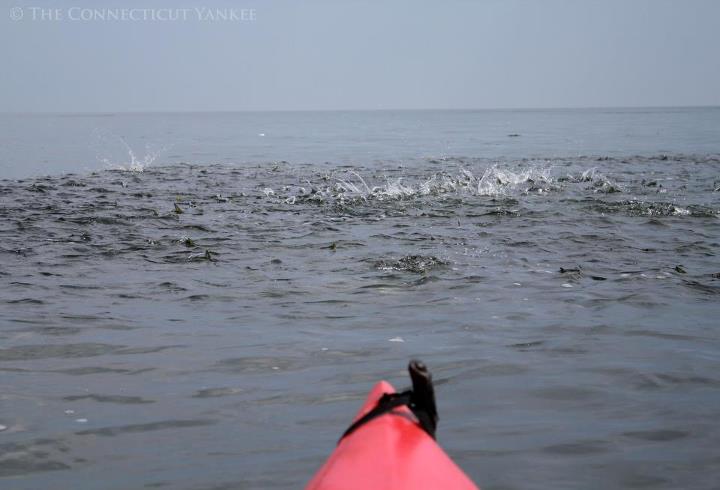Last week, the New Haven Register wrote a story about dead menhaden littering the banks of the Quinnipiac River recently. While the cause of the die off of thousands of bunker fish in the Quinnipiac River is not yet known, there is a likely scenario—and it’s one that does not spell environmental doom.

Mara Lavitt/New Haven Register
Menhaden, also called bunker, are schooling bait fish – silvery on the side, dark green on top, about a foot long. When they are unusually plentiful in the Sound – like this year – they can travel in huge schools. Ever since late June, there have been enormous numbers of smaller pods to giant schools all along the central Sound harbors, where they congregate to feed. This is a good thing, because bunker are the Big Macs of the Sound – everyone loves to feed on them. Big bluefish and striped bass love to munch on the adults, as do osprey and cormorant. Smaller juveniles are favorite food of everything from kingfishers to egrets and herons.
Bunker also are the key grazers of the Sound. If white tail deer are the grazers of our forest, then bunker and their distant cousin, river herring, are the Sound’s deer. When they are not being attacked by blues or stripers, they swim along lazily with their mouth and net-like gills open, literally netting hundreds of thousands of the little wiggly floating green and brown life that lives in our nutrient-rich Sound. The animals they graze on, collect and eat are tiny free-floating plant life (phytoplankton) and tiny wiggling animals (zooplankton).
For decades, we have been experiencing a historic overabundance of these forms of tiny plant and animal caused by all the nutrients we send into the Sound through sewage discharges and fertilizer running off our lawns and streets. When we get big schools of bunker, like this year, they are helping to re-balance the Sound, by grazing down tons of these tiny floating plankton.

Photo: Kierran Broatch
So how did a large school of bunker fish die in the Quinnipiac?
Quite likely, they were chased far up river in the Quinnipiac by large schools of bluefish. At low tide, when there is the least water, if tens of thousands of bunker are chased into a compact school of racing, churning fish, they can literally consume all the oxygen out of the water, and end up dying of suffocation. Remember that warm water can hold a lot less oxygen than cold water. The recent heat waves have raised reported temperature in New Haven harbor to as high as a whopping 77.8 degrees. Up river at low tide, that temperature might approach bath water temperature. Mix in shallow slow moving water and a mass of churning fish and you have a recipe for suffocation.
Rotting, smelly oily fish are a nuisance as they rot. And they are an eyesore. But they will be entirely consumed by gulls, crabs and snails within a week. The Quinnipiac River blue crabs will likely have a brief growth spurt from all the free eats.
Nature and estuaries like the Sound and mouth of the Quinnipiac are perfect recyclers.
You can read more about menhaden in a blog post from last month.
Posted by Curt Johnson, program director for CFE/Save the Sound
